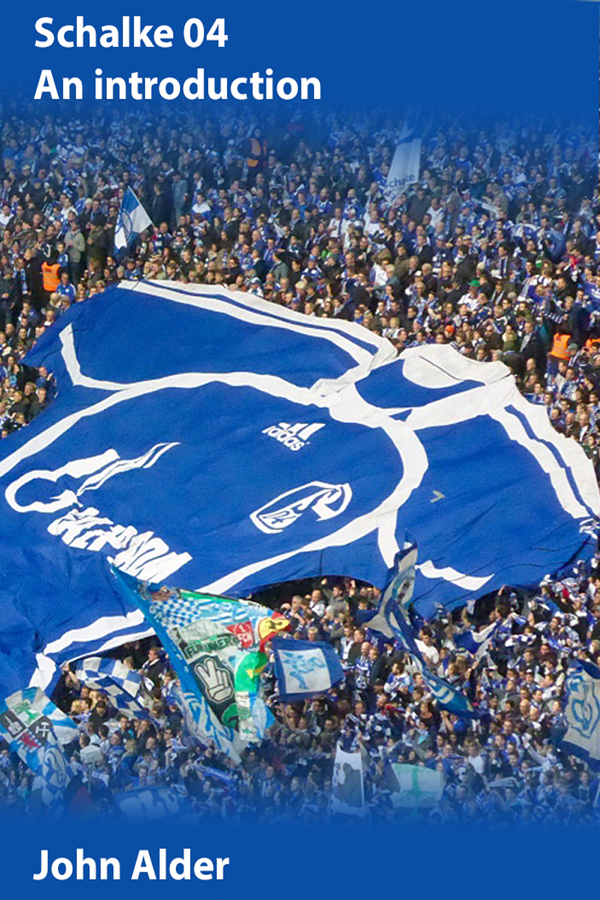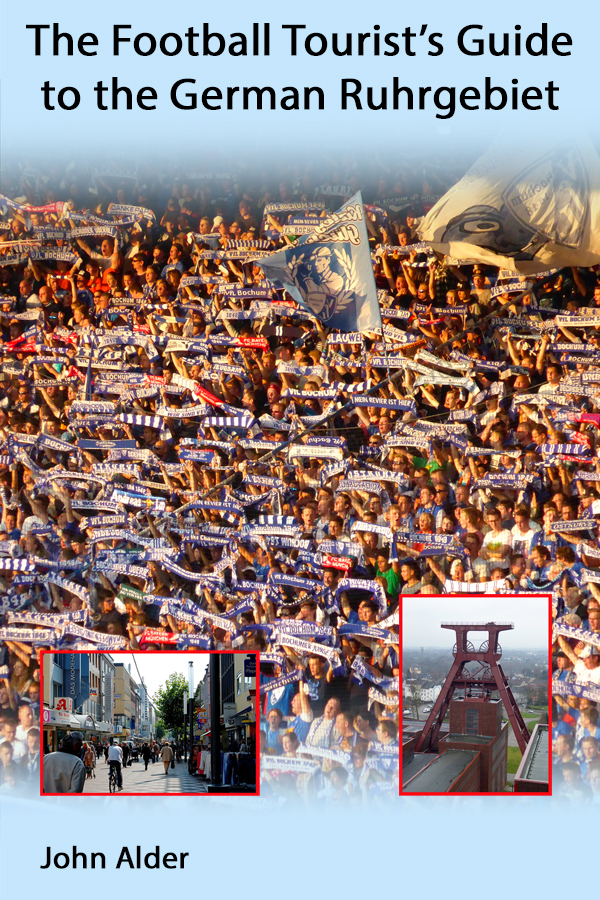FC Schalke 04
Based in Gelsenkirchen in the middle of Germany’s industrial powerhouse, the Ruhrgebiet, Schalke 04 is one of the biggest, oldest and best known clubs in the Bundesliga. It is said to be the 12th richest football club in the world.
The nickname, the Royal Blues, comes from Schalke’s colours – but they were originally known as “die Knappen’, which is a slang word for miners, because so many players and fans came from a mining background.
Schalke have one of the clearest and most informative websites in the Bundesliga, with plenty of information in English, and all you could want to know about the club, its history and its traditions.
You might also want to take a look at this video about a group of lifelong fans
Stadium
The Veltins Arena is without a doubt one of the finest stadiums in the world.
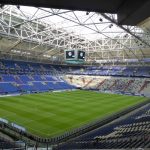 It opened in 2001 and quickly established itself as a first-class entertainment venue. Fans have flocked here to see top music acts like U2, Robbie Williams and Bruce Springsteen, sporting events such as the 2010 World Ice Hockey Championships and boxing – as well, of course, as football.
It opened in 2001 and quickly established itself as a first-class entertainment venue. Fans have flocked here to see top music acts like U2, Robbie Williams and Bruce Springsteen, sporting events such as the 2010 World Ice Hockey Championships and boxing – as well, of course, as football.
It can accommodate 61,973 football fans. There are 16,307 standing places, giving the club the second largest standing area in the Bundesliga. There is a retractable roof and withdrawable pitch and all seats give a fantastic view of the action. As you would expect, facilities and food outlets are also of a very high standard.
The Schalke Museum, which is just inside the stadium, opens on match days two hours ahead of kickoff. The exhibition describes the Schalke story through pictures, text and memorabilia. There are film extracts covering Schalke’s greatest moments and anecdotes about its greatest players. The visit is worth the 5 euros entry fee just for the breathtaking view of the stadium from one of the best vantage points.
You will not go hungry or thirsty at the Veltins Arena. There are 15 small restaurants, 50 grilling stations and 35 cafes – all connected by a 5km long beer pipe. On a typical match day they will sell 14,000 sausages, 43,000 rolls, 40,000 litres of drink.)
The stadium stands on its own and out of town, so you would think that there would not be much to do before the game. But the club has gone to great lengths to cater for fans who arrive early. There are kiosks selling food and drink on all the walkways to the ground. Beyond the training grounds – which are open to the public – there is a huge fan shop and a bar/restaurant. As a result, you are likely to see thousands of fans in the area two or three hours ahead of kickoff.
There is a cashless payment system throughout the arena. While this is extremely convenient for re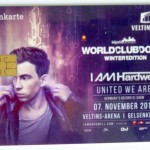 gular fans and reduces delays when buying food and drink, it can be a bit daunting for the one-off visitor from overseas. Using the system, however, is very straightforward. When you get inside, go to one of the countless kiosks issuing ‘Knappenkarten’. The card is free and you can load on as much money as you are likely to spend. When you want to buy something you hand over your card and then say what you want. They will then take the cost from you card. If you don’t spend all your money you can get a refund before you leave.
gular fans and reduces delays when buying food and drink, it can be a bit daunting for the one-off visitor from overseas. Using the system, however, is very straightforward. When you get inside, go to one of the countless kiosks issuing ‘Knappenkarten’. The card is free and you can load on as much money as you are likely to spend. When you want to buy something you hand over your card and then say what you want. They will then take the cost from you card. If you don’t spend all your money you can get a refund before you leave.
Going home is not quite a simple as arriving. Although extra trams and buses are laid on, moving 60,000 people is time-consuming and so it can take you a while to get back to the town centre. Similarly, Gelsenkirchen station and departing trains can be really crowded for a while after games.
My advice would be not to rush home. If you can, stay for a drink or two after the game. Stop off for something to eat in the city centre before catching your train
Before every game the entire stadium stands and sings along to the miners’ anthem ‘das Steigerlied’. At the same time, black and white footage of mining scenes is shown on the big screen. This moving tribute to those who have gone before will definitely give you goosebumps. The song dates back to the 16th century and is sung in mining areas all over Germany, as well as at political rallies. It’s about miners preparing for a long hard shift and hoping to get back to the surface safely. It starts and ends with the traditional miners’ greeting of ‘Glück auf’.
You can hear this song and see a homage to the Ruhr mining industry on YouTube.
Tickets
The club has an online ticket shop which is very simple to use. You could also give them a call. Games sell out very quickly, but there is a standby system, where you can get yourself put on a waiting list.
Directions
Getting there from the city centre is very straightforward. You go out of the main station, down some steps to the underground and catch tram 302. Your stop is conveniently called ‘Veltins Arena’ and your destination is about five minutes away.
Website
https://schalke04.de/en/
Where to stay in Gelsenkirchen
- Ibis Styles Hotel – right opposite the station.
- Ibis Gelsenkirchen – 100 yards from the station and old town
- Maritim Hotel
- Courtyard by Marriott – within walking distance of the Veltins arena
- Arena hotel – right next to the stadium
Not convinced?
I have written a couple of blogposts about Schalke 04.
Five things to do in Gelsenkirchen
1. Walk along the Schalker Meile
Schalke 04 was one of the first truly working class football clubs. Established in the early years of the 20th century, its players and fans came from the same town – Gelsenkirchen – and many from the Schalke district itself. This is where the miners and their families lived, worked and played. This is where Schalke’s first stadium – Glückauf-Kampfbahn – was built. This is where the triumphs of the 1920s and 1930s were celebrated.
Since those heady days, everything has changed. Thanks to de-industrialisation, the district has gone into steep decline and the thriving working-class community of old is no more. The club moved three kilometres to the north many years ago – first to the Parkstadion and more recently into the Veltins Arena. But many fans still cherish Schalke’s roots. They remember that Schalke is a place as well as a club. They lament the fact that you can support the modern Schalke 04 without ever setting foot in the part of town whose name the club carries and without knowing a thing about its origins and history.
In 2006 a group of fans got together to do something about this – to make sure that this part of town and it’s history do not get forgotten. They wanted to create a second royal blue haven.
And so the project Schalker Meile was born. The idea was fill a stretch of the road between the old Schalker Markt and the original Glückauf stadium – the route once walked by hundreds of thousands of fans – with as many reminders of Schalke 04 as possible.
Electricity pylons are painted in the club colours and empty shop windows are decorated with signs. The branding and advertising of local businesses all reference the club. There is even a tram stop called ‘Schalker Meile’.
The Schalke fan club (90,000 members) runs a pub called ‘Auf Schalke’.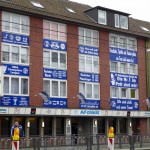
There is a fan shop nearby.
A bit further up you pass the tobacconist shop run by former player Ernst Kuzorra until 1974, when it was taken over by another Schalke legend – Reinhardt Libuda.
Towards the end of the Meile and right next to the old stadium there is another pub called ‘das Bosch’. This is where the players used to drink. A sign indicates Ernst Kuzorra’s regular seat. It’s now the home of a fan group called ‘Kuzorras grandchildren’ as well as pub of choice of countless Schalke fans. It gets its name from the famous landlord Gerd Bosch. Although he died in 1998 none of his successors have dared to change the name.
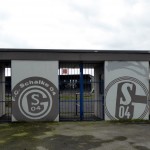 And finally, you arrive at the old Glückauf-Kampfbahn. Although looking sadly run down, it is still in use for youth games.
And finally, you arrive at the old Glückauf-Kampfbahn. Although looking sadly run down, it is still in use for youth games.
If you want to see this for yourself take the 301 tram and get off at the Schalker Meile stop.
This is the same tram that will take you to the Veltins Arena, and on match days many fans stop off there for a drink and to meet friends before continuing to the game.
On match days the club puts on a bus tour to the area, including a visit to the old stadium. A ticket will set you back 120 euros, but as well as the tour you get a meal, entrance to the Schalke museum and VIP seats at the stadium.
2. Visit the Schalke Museum
The Schalke Museum, which is just inside the Veltins Arena, opens on match days two hours ahead of kickoff, and is otherwise open all day. The exhibition describes the Schalke story through pictures, text and memorabilia. There are film extracts covering Schalke’s greatest moments and anecdotes about its greatest players.
However, the visit is worth the 5 euros entry fee just for the breathtaking view of the stadium from one of the best vantage points.
3. Wander round the city centre
If you or someone with you likes shopping, you will find everything you need a few minutes from the main station.
4. Have a walk in the Nordsternpark
This is a beautiful park on the site of a former mine. As well as fresh air and exercise, you can also get a meal or coffee and cakes in one of the many cafes.
5. Spend an afternoon at SPORT-PARADIES
This is a huge swimming complex, with slides and a wave machine. A great place to go if you have children with you. The open-air pool next door is open in the summer.
To get there you catch the 380 or 381 bus towards Gelsenkirchen Buer and get off at the stop ‘Gelsenkirchen SPORT-PARADIES”
